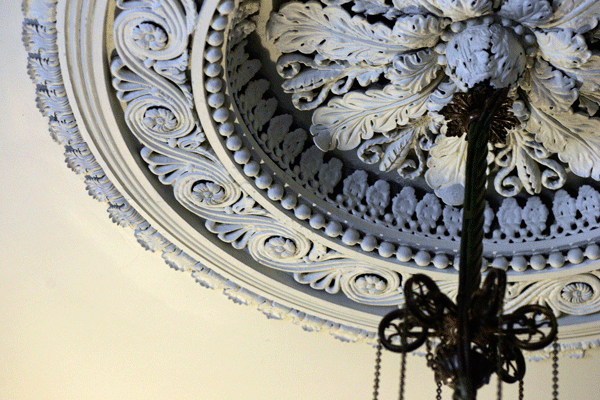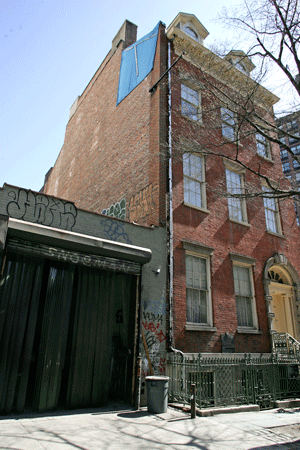
BY SAM SPOKONY | To the dismay of advocates for the historic Merchant’s House Museum, the city’s Landmarks Preservation Commission finally approved a plan for the construction of an eight-story hotel next to the museum, in a six-to-one vote on April 8.
The planned 27 E. Fourth St. hotel — which would sit immediately to the west of the 29 E. Fourth St. museum — had twice been rejected by L.P.C., after first being introduced in 2012 as a nine-story structure. But the final design’s slightly smaller scale, along with other exterior changes, apparently led the commission to allow it to go forward.
It’s still unknown when demolition of the existing one-story structure at 27 E. Fourth St. will take place, and when the subsequent construction will begin, since the team behind the hotel — led by developer Constantine Fotos and architect Ed Carroll, of SRA Architecture + Engineering — has not yet applied for the necessary permits through the city’s Department of Buildings.
Now, museum advocates are preparing to face an issue that, among other things, led them to so strongly oppose the development — namely, the fear that the new construction will cause great, or even irreparable, damage to the 182-year-old building’s original plasterwork, which is considered by some experts to be among the finest in the nation.
“We’re in triage mode,” said Margaret “Pi” Gardiner, executive director of the city-owned museum. “And now it’s going to be critical for us to fundraise for the legal and engineering expenses necessary to try to maintain the safety of the house.”

The four-story Merchant’s House — both a New York City landmark and a national historic landmark — has remained virtually intact since its construction in 1832, and now serves to educate the public about the domestic life of the wealthy merchant family and four Irish servants who once lived there. Notably, the structure has gained landmark status not only for its exterior, but for its interior, which features the famed plaster.
“I think it’s the best plasterwork I’ve ever seen,” said David Flaharty, an expert ornamental plasterer who has done work for the White House, the U.S. State Department and New York’s Metropolitan Museum.
Part of the fear shared by Gardiner, Flaharty and numerous museum supporters is based on the fact that much of that highly intricate plaster is located inside the house’s western wall — the wall closest to the new construction, and therefore the one that will take the worst beating.
Demolition to the east of the Merchant’s House in 1988 caused nearly $1 million worth of structural damage and forced the museum to close for two years, but it spared the plaster. Now, the advocates believe jackhammering and bulldozing on the western lot will leave the museum in danger of losing the plaster forever — or, at the very least, require highly expensive preparations just to minimize that damage.
The hotel’s development team has, over the course of their L.P.C. application process, promised that they will closely monitor the excavation and foundation work — which will cause the greatest vibrations — in order to prevent damage. But museum advocates don’t believe that pledge will be enough.
“No assurances on earth would convince me that construction on the west side of the building will take place without damage to the museum,” said Michael Devonshire, director of conservation at Jan Hird Pokorny Associates, which has done restoration work for the Merchant’s House since 1990.
Devonshire is also a voting member of the L.P.C., but the commission’s legal team forced him to recuse himself from all aspects of the 27 E. Fourth St. decision because of his ties to the museum.
He estimated that the preparations needed to shore up the museum’s plasterwork will cost up to $80,000, and that the resulting damage — even with that additional support — will cost around $200,000 to repair.
“In my estimation, the Merchant’s House is without a doubt the most important historic house museum in this city, and unfortunately it’s now probably the most endangered one,” said Devonshire.
And, again, those costs may be just the tip of the iceberg for the museum, which relies on both government grants and private donations for its survival.
Gardiner said that, along with paying for numerous engineering studies to help prepare for the eventual construction, the museum will have to fund its lawyers as they attempt to work out more specific deals with the hotel development team regarding damage prevention.
Along with a protection plan directly focused on the plasterwork, the executive director explained that she’s pushing for three additional agreements to further mitigate building vibrations, water infiltration and building settlement.
The developer has predicted that work on the new hotel will cause the Merchant’s House to settle, or shift, about a quarter of an inch — an amount of movement that musuem engineers have said will undoubtedly cause damage. But some of those engineers have also predicted that the museum could potentially shift up up to an inch and three-quarters, leading to far more disastrous effects, according to Gardiner. And a contractual agreement regarding that process could play a vital role in helping to force the developer to stop or alter its work if the building’s settling approaches a certain threshold.
“We’d really hoped that the L.P.C. would have taken the initiative on those extra protection plans,” said Gardiner, “but they didn’t, so now it’s up to us.”
Neither Fotos nor SRA Architecture responded to request for comment.
Meanwhile, top city preservationists have pledged to support the Merchant’s House as it struggles onward — as they have since the first L.P.C. hearing in 2012 — while expressing extreme disappointment at the commission’s decision to approve the new development.
“It’s not over for us,” said Andrew Berman, executive director of the Greenwich Village Society for Historic Preservation. “The fact that the city would approve this without explicitly sufficient safeguards for the Merchant’s House’s structural integrity is, quite frankly, shocking. And if there are any issues that come up during construction, we’ll definitely step in to push hard on the city agencies to make sure no illegal or shoddy work is going on.”
Simeon Bankoff, executive director of the Historic Districts Council, said his group will “support our friends at the Merchant’s House in any way possible.” He echoed Berman’s sentiments regarding the lack of explicit protections involved in the L.P.C. approval.
“The fact is that New York City has plenty of boring eight-story hotels,” said Bankoff, “but we only have one Merchant’s House.”

















